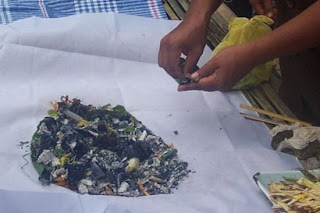
A Ngaben ceremony can be done in a modest to extravagant way, a modest ngaben needs a few basic offerings and preparations; while the extravagant ngaben will involve massive offerings, cremation tower, cow sarcophagi (befitting the caste of the deceased), gamelan orchestra and hundreds of manpower; while Mekingsan ring Geni (buried in the fire) is always a simple affair regardless the caste of the deceased, with only a few offerings, few manpower and little preparations.

A ngaben ceremony functions as final send off of the deceased body (not the soul), in this ceremony the body of the deceased is returned to five basic elements of nature (panca mahabhuta, which are pertiwi = earth, apah = water, teja = light or fire, bayu = wind, akasa = ether, space, void). In Balinese cosmology, the human body is a representation of the universe, and built with same elements as universe, in ngaben ceremony all these elements is returned to their respective source. A Mekingsan ring Geni ceremony is not a final send off; it functions to buy time until the proper Ngaben ceremony can be held for the deceased.

In the old days, the most common way to buy time is by burying the body of the deceased in the cemetery and unearthing it when the time for ngaben ceremony is come. But a problem arose in relation with this practice in 1963. The great centennial purification of the world ceremony (Eka Dasa Rudra) was held in 1963 (end up with eruption of Mount Agung and considered as a failure, re-enacted successfully in 1979). During the official preparations and execution of this grand ceremony (around 3 months), all cemeteries in Bali had to be emptied and no cremation ceremony was allowed.

All the buried corpses were unearthed and given ngaben ceremonies before the official preparations of ceremony were started. “But if there is someone who dies during the preparations and execution of ceremony, what can we do?” This was a serious question since the burial and ngaben could not be done during the preparations and execution of the ceremony and the corpse could not left to rot in the house compound, a way out had to be found. The high priests of Bali held a meeting and the problem was solved with mekingsan ring geni (since it is forbidden to bury a corpse in the ground and to hold ngaben during the ceremony, then let the corpse be buried in the fire).
Though the practice of “mekingsan ring geni” is “invented” to cope with the delicate situation in the past many Balinese nowadays continue to bury their deceased family member in the fire in order to avoid unearthing the remnants of the deceased in the future.













0 comments:
Post a Comment